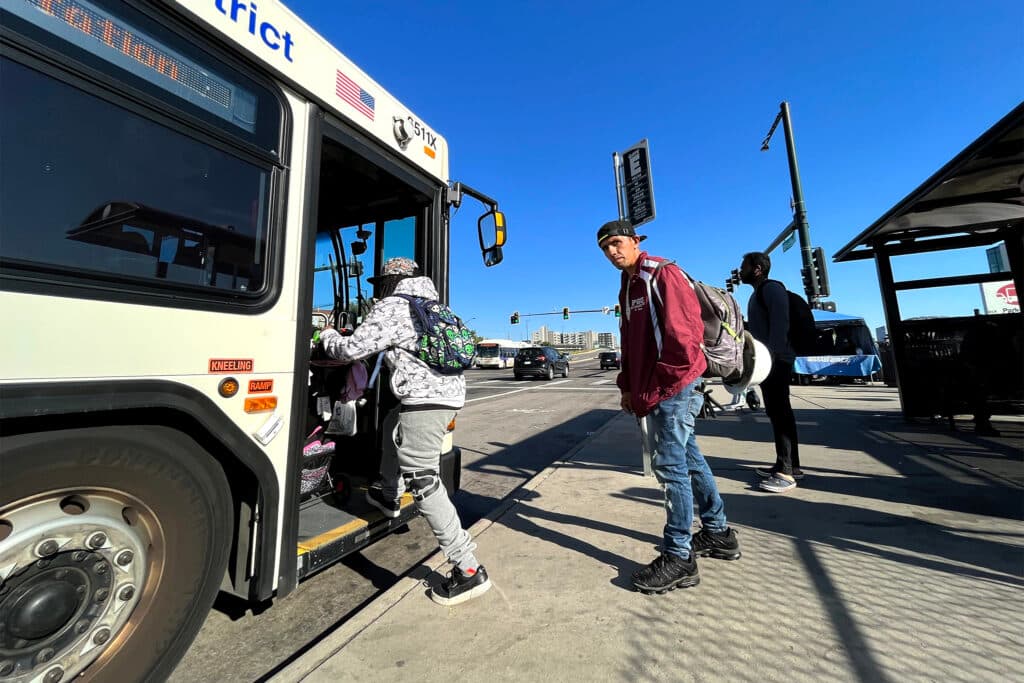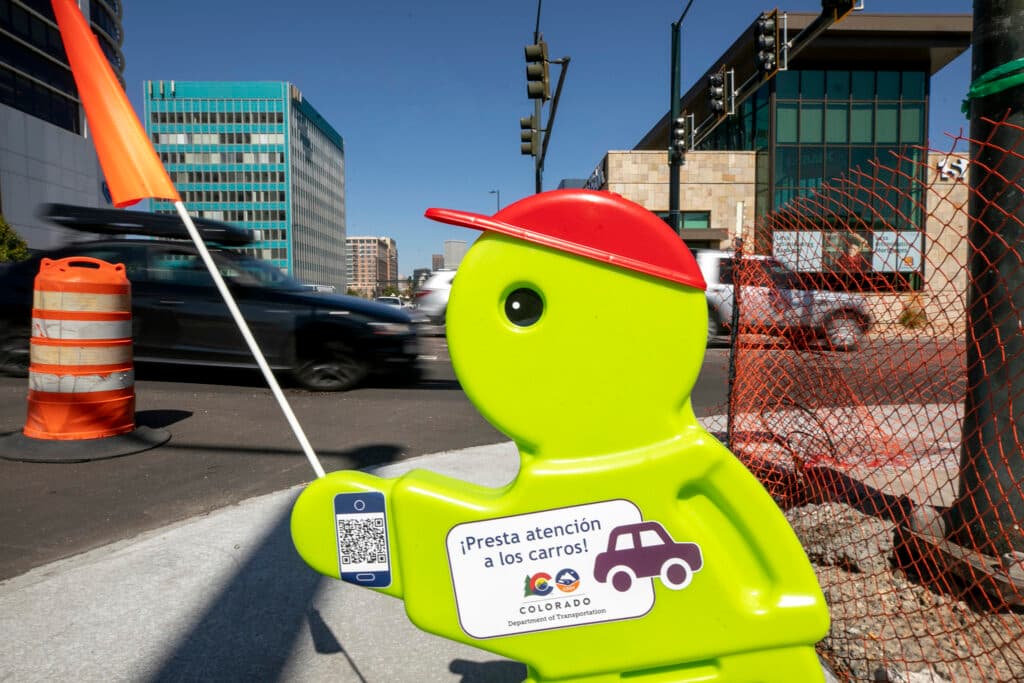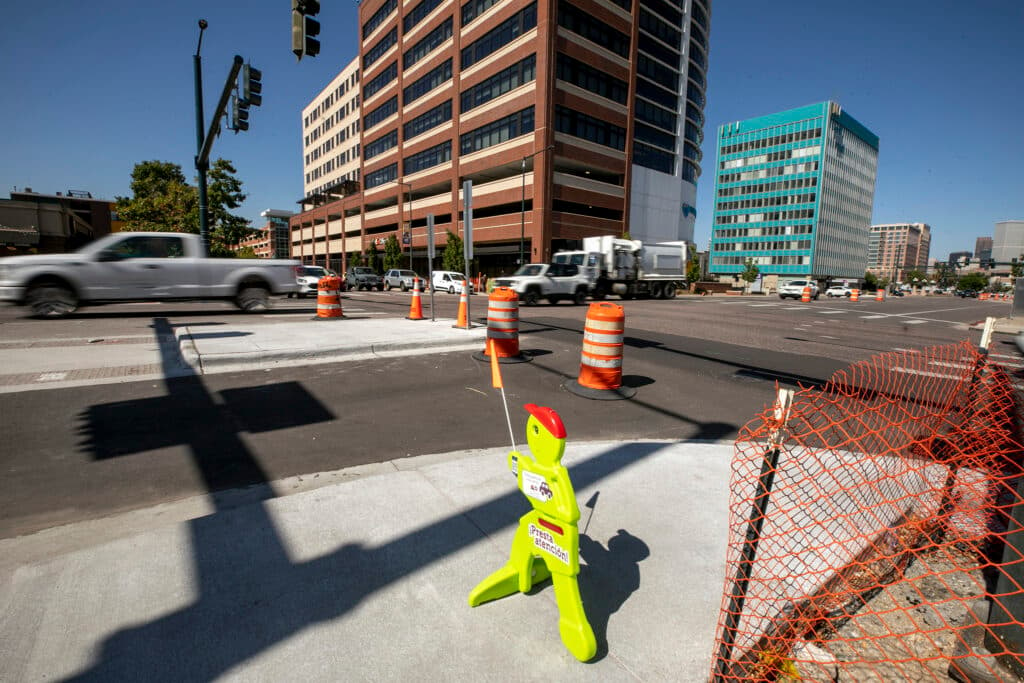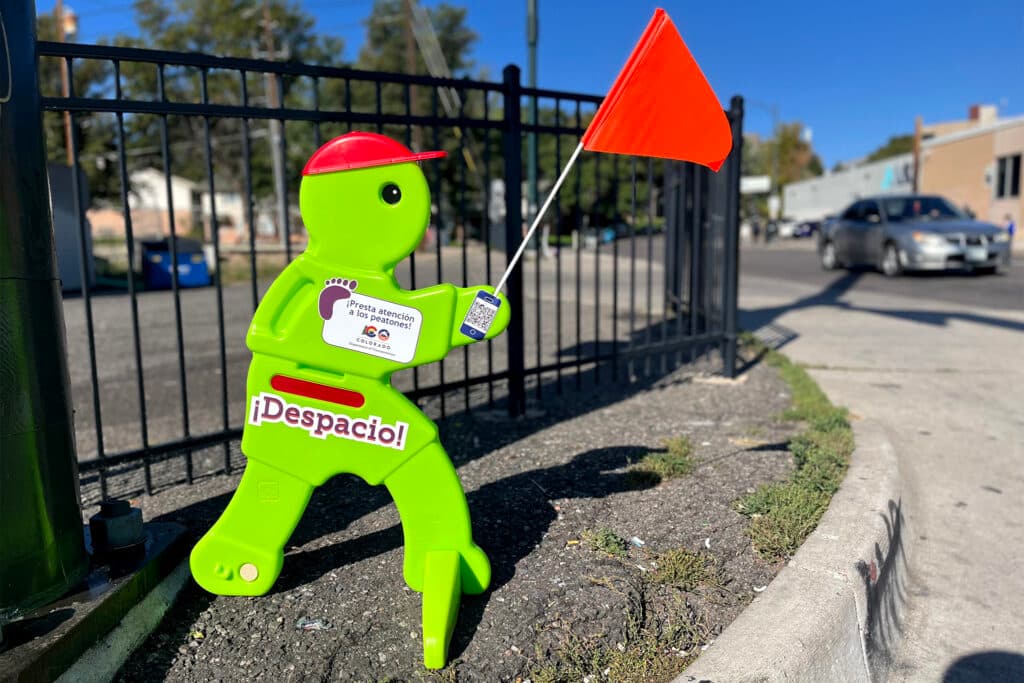Ciera Trowell only had a minute to talk. The Denver resident was pushing a stroller and was about to catch her bus at the busy intersection of 14th Avenue and Federal Boulevard.
It's an intersection she prefers to avoid.
"I think these cars drive too fast," she said as vehicles blazed by almost certainly higher than the posted limit of 35 mph. "I think they should change the speed limit. I've seen a few people get hit and it's not pretty. A lot of them keep going."

CDOT this week recognized this and other dangerous intersections in the Denver metro as part of a safety campaign meant to raise awareness among drivers and pedestrians about rising pedestrian deaths. Four were killed over the weekend, and the state is on pace to break last year's record high of 115 pedestrian deaths.
As part of that campaign, CDOT placed short, plastic "neon navigators" at those intersections on Thursday.
Trowell, and half a dozen other pedestrians Denverite spoke with Thursday morning, were not impressed with CDOT's effort.
"I feel like they don't care," Trowell said, adding of the stubby green cutout: "Who's going to pay attention to that?"

The one-day campaign is meant to kickstart conversations about pedestrian safety, said CDOT traffic safety manager Sam Cole. The agency is doing far more to address pedestrian safety than this "small effort," he reiterated, which cost around $1,000.
"When it comes to improving our roadways and addressing pedestrian safety, infrastructure changes are front and center as they should be," Cole said in an interview.
"But I think awareness can't be forgotten about," Cole continued. "Getting people's attention to this issue is my job, and this is just a small way that we're trying to get people's attention."
Still, the little green dudes weren't getting much attention on Federal Boulevard Tuesday morning.
Federal Boulevard serves Denver's west side as both a main street, full of shops, homes and their associated traffic, as well as a state highway designed to move vehicles quickly.
It's a dangerous combination: Denver city data show more than 11,000 crashes along the corridor since 2013, with at least 443 serious injuries and 41 deaths. Nineteen of those killed were pedestrians.
The intersection at 14th Avenue, just steps from CDOT's headquarters, is particularly dangerous. Drivers traveling south roll down the Colfax viaduct and pick up speed just as they reach 14th Avenue, which hosts a handful of major bus stops and an RTD light rail station.

Pedestrians pulse through the area all day and night, often crossing Federal's eight lanes of traffic. One of them on Thursday morning was Terry Rogers, who was rolling his way to a bus stop.
"With these triple lanes ... going both ways, they don't give people in wheelchairs enough time to get across the street," Rogers said.
What did he think of the neon navigator?
"You can't even see it," Rogers said.
Did he think it was sufficient to deal with the problem?
"No," he said. "Sure don't."
Most other pedestrians Denverite spoke with agreed with Rogers' assessments -- that there wasn't enough time to cross the road, that cars travel too quickly, and that the neon navigators were insufficient at best.

"A lot of people won't even know what it means," said Delena Thornton, who was traveling through the area on her way to a dentist appointment.
Over on Broadway and Sixth Avenue, pedestrian Dan Schoenwald was similarly not impressed by the neon navigator. He'd much rather see infrastructure improvements, he said.
"Something smarter than this," he said.
Transportation officials have long relied on unproven safety campaigns. CDOT says they're part of a bigger strategy
Research shows that many information-only safety programs do little to change road users' behaviors for the safer.
"Historically, many of these efforts have been of poor quality, consisting of passive messaging, sloganeering, exhorting people to do -- or not do -- some behavior, and delivered to an undifferentiated audience over the short term," authors of one 2008 study wrote.
"... highway safety messages conveyed in signs, pamphlets, brochures, on buttons, etc. may increase awareness of the health issue being addressed and reinforce social values, but are unlikely to have any effect on behavior," they continued.
Such programs are popular, researchers say, because they are easy and "give the appearance of doing something important for society."
Denverite asked CDOT's Cole what evidence he had that his campaign would help reduce pedestrian deaths. His goal, Cole replied, was to get more attention to traffic deaths and injuries.
"We're just not having conversations about pedestrian safety," Cole said.

One reason for that, said AAA Colorado spokesman Skyler McKinley, is that elected officials have not championed the issue even as deaths have reached record levels.
"When it comes to traffic safety, we're not getting daily press conferences -- we're not getting any press conferences," he said. "We're not getting the sort of political leadership with folks staking a flag in the ground and saying, 'we're going to solve this.' "
Denver leaders did make a splash six years ago when they adopted the "Vision Zero" goal of eliminating traffic deaths and serious injuries.
But that plan has languished, with deaths rising as city and state leaders have been slow to make the sweeping changes to streets advocates say are necessary. City leaders, for example, as of this summer, had not asked CDOT to lower speed limits on any state-owned road in Denver.
Those big, structural changes are coming, Cole said, referring to CDOT safety programs aimed at lowering speed limits and rebuilding dangerous urban roads. They just take time to take effect, and can be less noticeable than a colorful safety campaign.
"A huge change is taking place," Cole said. "It's going to take a long time, but I think change is moving in the right direction ... But what we're running up against is the fact that over the last many, many decades, roads were designed for vehicles and we're now having to address that."
Denverite's Kevin J. Beaty contributed to this report.













